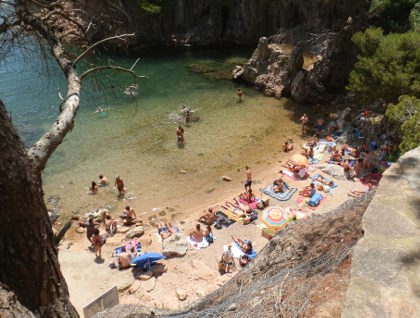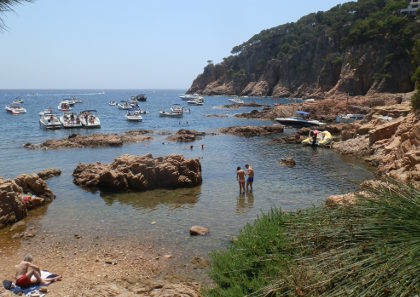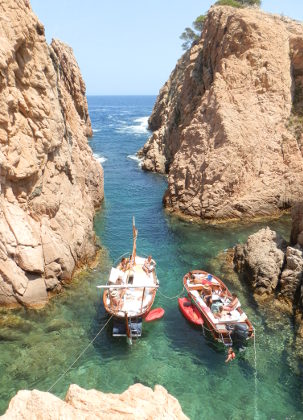Swimming at Aigua Xelida (Tamariu)
 After a very hot June, summer is fully with us for July and we're returning to the beaches for swimming and canoeing. Having revisited Aigua Xelida near Tamariu for a walk, we returned by canoe from Tamariu, and then a third and forth time for swimming because of it's lovely hidden coves and ravines which make for excellent adventure-style swimming.
After a very hot June, summer is fully with us for July and we're returning to the beaches for swimming and canoeing. Having revisited Aigua Xelida near Tamariu for a walk, we returned by canoe from Tamariu, and then a third and forth time for swimming because of it's lovely hidden coves and ravines which make for excellent adventure-style swimming.
Aigua Xelida itself is just around from Tamariu, a diversion off the Tamariu to Begur road that runs past Aiguablava and Fornells. As a beach it is tiny - space for less than forty people with a mix of grit and rocks and a small stream cutting through half the beach. Normally the water is a beautiful crystal clear emerald colour with a bay that is framed by cliffs and rocky outcrops. The beach actually sits on the righthand side of the bay (looking to sea), but the bay continues around two fishermen's houses to a second even smaller gritty beach surrounded by rocks and a headland/island.
What we hadn't realised until we explored by canoe, was the number of coves and hidden passageways in between the rocks and islands. In particular there is a long narrow sea-ravine just behind the second gritty beach, a hidden cove, and out of the cove and into deeper sea, too the left is another hidden bay under the cliffs inaccessible except from the water, but with lucent clear water.
 For swimmers who like to explore there are lots of rocks, fish, clear water pools and even opportunities for jumping from rocks into some of the deeper pools like in the ravine. The one piece of advice would be to wear water-shoes when swimming both to help clambering in and out of the rocks, but also because the bay is a little stony in places and there are occasional sea urchins in the water. Goggles to keep an eye on the water depth are also recommended.
For swimmers who like to explore there are lots of rocks, fish, clear water pools and even opportunities for jumping from rocks into some of the deeper pools like in the ravine. The one piece of advice would be to wear water-shoes when swimming both to help clambering in and out of the rocks, but also because the bay is a little stony in places and there are occasional sea urchins in the water. Goggles to keep an eye on the water depth are also recommended.
We also discovered that there is now a long-distance (1.2km) Vies Braves swimming route around the headland to the right ending at Tamariu. This is the first time we've seen these routes, but there are now ten long-distance swimming routes up and down the Costa Brava.
Facilities at the beach
There are no facilities at the beach. It is left natural and there are no lifeguards. Neither are there shops or other facilities nearby. Because it's tiny in summer there is barely enough space for all the towels.
Sand quality
The sand is rough with occasional small stones and runs into rocky outcrops under a small barraca (fisherman's hut) at the back of the beach. Although not too bad underfoot by the water, getting into the water there are pebbles and stones under foot. Water-shoes makes the swimming much much easier.
A second, even smaller beach, is accessible by the path behind the fisherman's houses with grittier sand and a shallow but rocky bay.
Swimming
 Into the bay from the main beach the shelf is gradual to start but then runs deeper. Once in the water you're almost immediately swimming in a bay lined with rocks and underwater ravines in among little islands and rocky outcrops. There are plenty of fish and items of interest under water. The rocky outcrops and islands mean that you should keep an eye out for water depth as many rockier areas get close to the surface.
Into the bay from the main beach the shelf is gradual to start but then runs deeper. Once in the water you're almost immediately swimming in a bay lined with rocks and underwater ravines in among little islands and rocky outcrops. There are plenty of fish and items of interest under water. The rocky outcrops and islands mean that you should keep an eye out for water depth as many rockier areas get close to the surface.
The water further out gets deeper and the bay fills with boats, so would be good for longer distance swimming, but the whole area is just excellent for exploratory and adventure swimming.
If you swim across the bay, you'll need to navigate through the gaps between the rocks, or clamber over the low islands but there is a lot to explore. Our favourite feature was the ravine behind the second grittier beach on the left hand side. The whole headland has small sea canyons - the main ravine is accessible from the beach side of the bay and cuts through the headland/island. It has steep walls but deep pools and we've seen people jumping from high into the water. The ravine is very sheltered and occasionally boats and canoes visit. At the far end it opens into the open sea, but from the sea side there are further hidden coves under the rocks.
The ravine has a channel off to the right (looking out to sea) and this gives a small channel that accesses back into the bay after a scramble over rocks. Next to the ravine to the left is another small bay which also opens out to the sea. The gap is narrow and if the sea has a swell it might be difficult to get in and out.
Since the ravines and coves are often hidden from view or inaccessible from the land, we'd recommend swimming in pairs or with a boat nearby. It would be easy for an inexperienced or younger swimmer to get into trouble unseen and then find swells and rocks barring access to safer waters.
Canoeing
Canoeing is excellent, but there is nowhere to launch the canoe from, so it would involve paddling around either from Aiguablava or from Tamariu. We went from Tamariu with a south wind, which meant a swell on the sea, but very calm conditions protected by the bay in Aigua Xelida.
Parking
The estate above Aigua Xelida has parking. If the car park is full, so is the beach.
Walks and exploring
We covered Aigua Xelida recently on our walks Tamariu - Aigua Xelida. A route is available that connects with Tamariu town (lots of steps though), or it's up-hill on the road and over to Aiguablava.
Next beaches
South to Tamariu - North to Aiguablava/Fornells (Begur)

 Walks and other things
Walks and other things